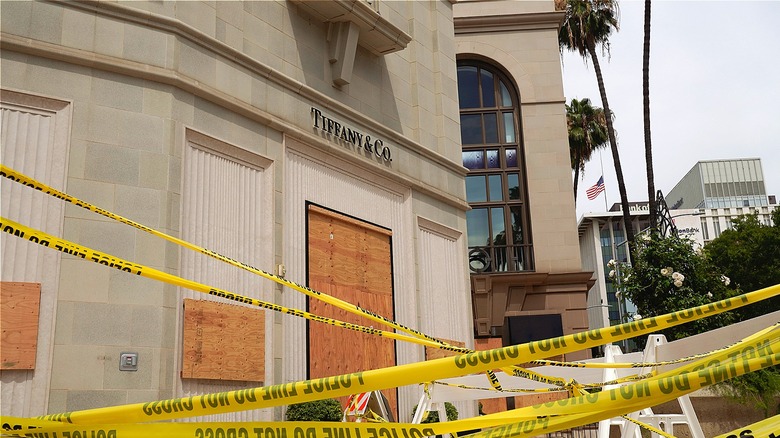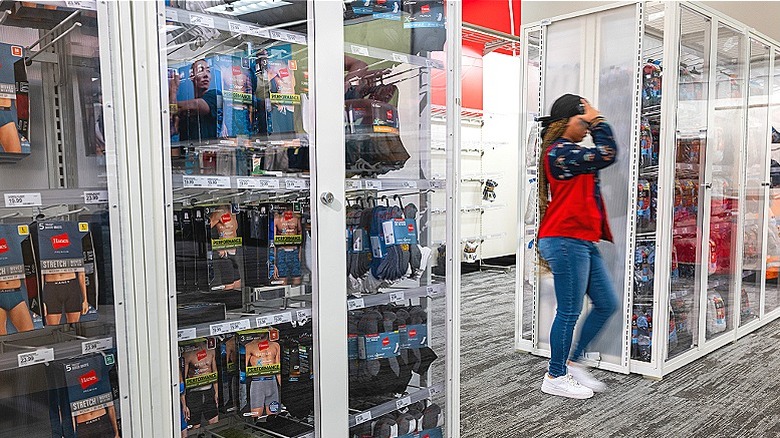Flash Mob Theft Costs Retailers More Than You Probably Realize
Whether you've seen the videos or read the news, chances are you know about the strings of retail theft happening across the country. From completely empty shelves at CVS in Washington D.C. to smash-and-grabs at luxury stores in California, retail theft seems to be everywhere. It's also alarming just how much of the recent theft has been pre-planned and organized — sometimes with groups as large as 70 people. As retailers struggle to keep up with the rise in retail crime, you might be asking yourself just how financially damaging these retail thefts are, especially for large corporations that generally factor in a certain amount of "shrink" (i.e., theft) into their budgets. Turns out, even with company expectations of theft, the recent increases amounted to over $112 billion in losses in 2022.
Based on its 2023 National Retail Security Survey, the National Retail Federation reports that the 2022 losses represented a 19% increase over 2021 theft losses (which were $93.9 billion). NRF Vice President for Asset Protection and Retail Operations David Johnston explained, "Retailers are seeing unprecedented levels of theft coupled with rampant crime in their stores, and the situation is only becoming more dire." While shoplifting is bad enough, retailers in the United States are reporting an alarming uptick in organized retail crime, with 67% of survey respondents reporting an increase in both violence and aggression from organized theft perpetrators than in years prior. Let's break down what separates organized retail theft from a retailer's expected shrink, and if anything can be done about it.
Rise of organized retail theft
One of the most disruptive forms of retail theft that's increased in recent years is flash mob-style organized thefts. Whether looters hit a string of stores or focus their attention on clearing out one, it generally involves a large group of would-be thieves attacking a specific retail location all at once. Since most retailers don't have the security or staffing required to combat this tactic, thieves have generally been successful. Many of these thefts are pre-planned on social media and the stolen items are then re-sold either online or to other retailers for cash. This is what separates organized retail crime from, say, shoplifting, since the thieves don't intend on using the stolen goods in question, personally, but rather as a means to make money.
While flash mob-style retail crime sprees have received the most media attention, there are other organized theft operations that are also negatively impacting retailers. Cargo theft, in particular, has been an increasing problem with CargoNet reporting a 57% increase in this type of theft compared to 2022. According to its statistics (of U.S. and Canadian cargo thefts), thieves made off with over $44 million across 582 incidents in the second quarter of 2023 alone. (You might remember the pictures of looted boxes lining train tracks in LA in 2022.) Other organized crimes the NRF has highlighted include credit card theft, bar code tampering, and abusing store return policies to receive cash for stolen merchandise.
The impact of retail theft
While news coverage of retail crime sprees can make it seem as though retailers are under constant assault from thieves, note that flash mob-style thefts are categorized as external theft, and according to NRF's 2023 retail security survey, external theft accounted for 36% of total retail losses for 2022. Meanwhile, 29% of losses were due to employee theft while a whopping 27% of retail losses were due to cashier error and/or incorrect pricing on items. And so, while theft is definitely up across the board, flash mob thefts are by no means the singular factor affecting retail businesses.
If you find yourself wondering why retail thefts should concern you, consider the safety concerns involved. With retailers reporting higher rates of violence accompanying theft incidents, companies are increasingly choosing to close locations altogether out of safety concerns. Target closed stores across four different states in September 2023, citing theft as the major safety concern behind the closures. Walmart, Nordstrom, Macy's, and CVS have also all closed stores.
Besides closing stores, retailers have also resorted to locking up products in cases (among many other theft-deterrent tactics) that require staff assistance to shop for items. This leads to not only a more frustrating customer experience but also added pressure on retail employees at a time when finding staff has been incredibly difficult. Between theft crime and an increase in employee assaults and harassment, retailers have struggled to hire enough staff in the wake of very real safety fears.


